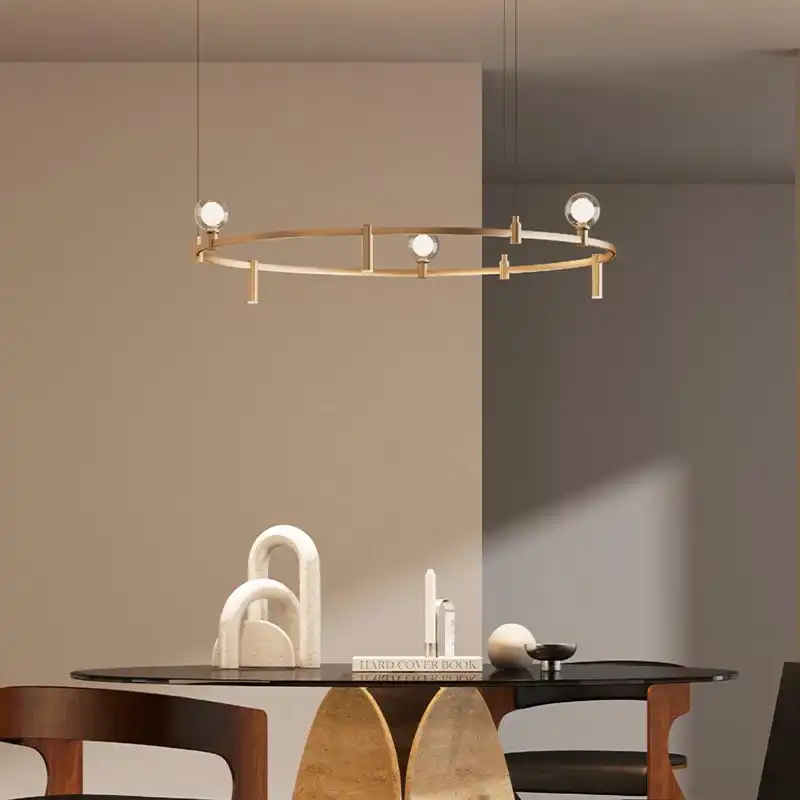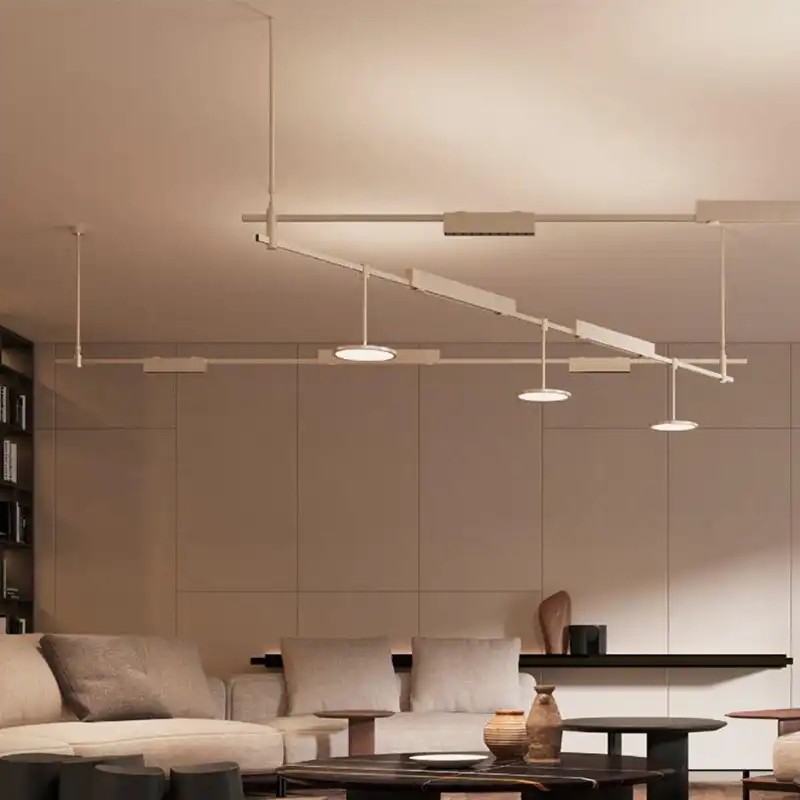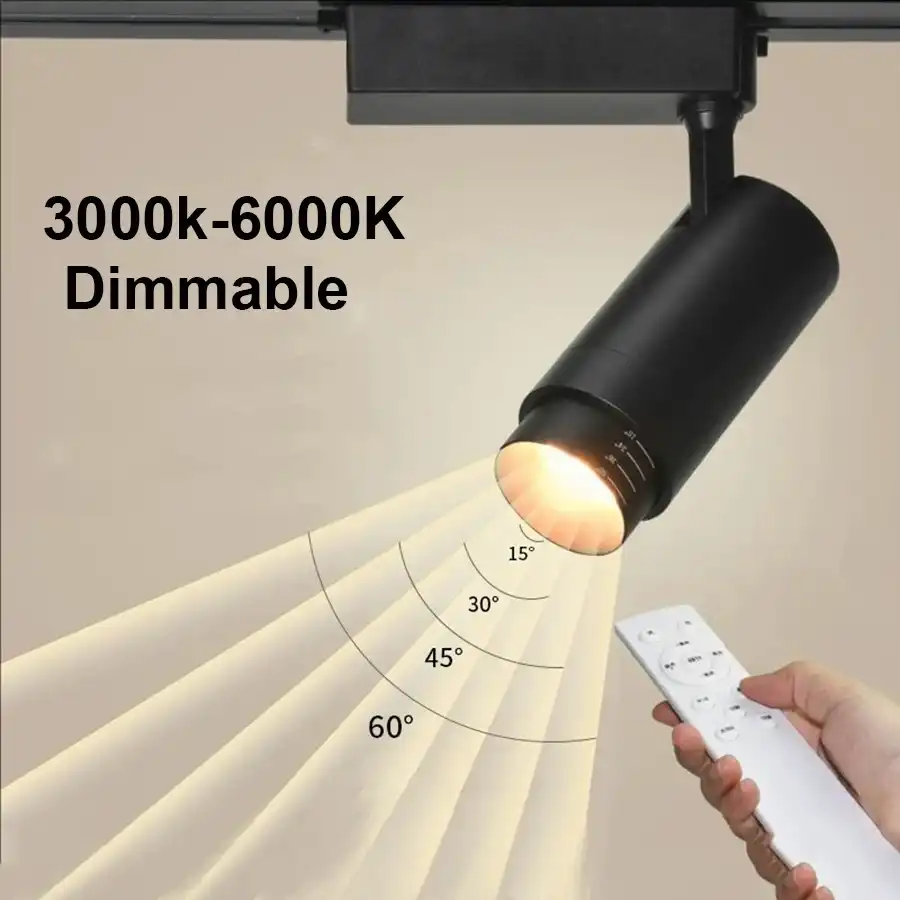Understanding Magnetic Lighting Systems
Magnetic lighting systems represent a cutting-edge approach to illumination, combining the latest LED technology with innovative magnetic attachment methods. These systems typically consist of two main components: a magnetic track or surface and the light fixtures themselves, which attach magnetically to the track or surface.
The Science Behind Magnetic Lights
Magnetic lights operate on a simple yet ingenious principle. The base of each light fixture contains strong neodymium magnets that securely attach to a ferromagnetic track or surface. This magnetic connection not only holds the fixture in place but also conducts electricity, eliminating the need for complex wiring or additional connectors. The result is a clean, streamlined look that allows for easy repositioning and customization of your lighting setup.
Types of Magnetic Lighting Fixtures
There's a wide variety of magnetic lighting fixtures available to suit different needs and aesthetics. Some popular options include:
- Magnetic spotlights: Perfect for accent lighting and highlighting specific areas or objects
- Linear magnetic lights: Ideal for creating continuous lines of light along walls or ceilings
- Magnetic pendants: Suspended fixtures that add a decorative touch to any space
- Magnetic track lights: Versatile systems that allow for multiple fixtures on a single track
Each type of magnetic light offers unique benefits and can be used in various combinations to achieve the desired lighting effect in your space.
Advantages of Magnetic Lighting Systems
Magnetic lights offer several advantages over traditional lighting solutions:
- Flexibility: Easily reposition or reconfigure lights without tools or professional help
- Scalability: Add or remove fixtures as needed to adapt to changing requirements
- Clean aesthetics: Achieve a sleek, minimalist look without visible wiring or bulky fixtures
- Energy efficiency: Most magnetic lights use LED technology, consuming less power and lasting longer
- Easy installation: Simplified setup process compared to conventional lighting systems

Choosing the Right Magnetic Lights for Your Space
Selecting the perfect magnetic lights for your space involves considering several factors to ensure optimal illumination and aesthetic appeal.
Assessing Your Lighting Needs
Before diving into the world of magnetic lights, it's crucial to evaluate your specific lighting requirements. Consider the following questions:
- What is the primary purpose of the lighting in each area? (e.g., task lighting, ambient lighting, accent lighting)
- How much natural light does the space receive?
- What are the dimensions and layout of the room?
- Are there any architectural features or artwork you want to highlight?
- What is the overall style and color scheme of the space?
By answering these questions, you'll have a clearer understanding of the type and quantity of magnetic lights needed to achieve your desired lighting goals.
Considering Light Output and Color Temperature
When selecting magnetic lights, pay attention to two critical factors: light output and color temperature.
Light output, measured in lumens, determines the brightness of the fixture. The required lumen output depends on the size of the space and the intended use of the light. As a general rule:
- For ambient lighting: 10-20 lumens per square foot
- For task lighting: 20-50 lumens per square foot
- For accent lighting: 30-40 lumens per square foot
Color temperature, measured in Kelvin (K), affects the mood and perception of a space. Lower color temperatures (2700K-3000K) create a warm, cozy atmosphere, while higher color temperatures (4000K-6500K) produce a cooler, more energizing light. Consider the following guidelines:
- Warm white (2700K-3000K): Ideal for living rooms, bedrooms, and relaxation areas
- Neutral white (3500K-4000K): Suitable for kitchens, bathrooms, and workspaces
- Cool white (4000K-6500K): Best for areas requiring high visibility or mimicking daylight

Evaluating Design and Aesthetics
Magnetic lights come in a wide range of designs, from minimalist and modern to more ornate and decorative styles. When choosing fixtures, consider how they will complement your existing decor and architectural elements. Some factors to consider include:
- Fixture shape and size
- Finish and materials (e.g., brushed nickel, matte black, polished chrome)
- Beam angle and light distribution pattern
- Integration with smart home systems or dimming capabilities
Remember that magnetic lights offer the unique advantage of easy repositioning, so don't be afraid to experiment with different configurations to find the perfect look for your space.
Installation and Maintenance of Magnetic Lights
One of the most appealing aspects of magnetic lighting systems is their ease of installation and maintenance. However, it's essential to follow best practices to ensure optimal performance and longevity of your fixtures.
Installation Tips for Magnetic Lights
While magnetic lights are generally easier to install than traditional lighting systems, proper installation is crucial for safety and performance. Here are some key tips to keep in mind:
- Ensure the magnetic track or surface is securely mounted to the wall or ceiling
- Follow manufacturer guidelines for spacing between fixtures to prevent overloading
- Use a level to ensure tracks are perfectly straight for a professional look
- Consider hiring a professional electrician for complex installations or if you're unsure about electrical work
- Test all fixtures before finalizing the installation to ensure proper functionality
Many magnetic lighting systems are designed for DIY installation, but always prioritize safety and consult a professional if you have any doubts.
Maintaining Your Magnetic Lighting System
Proper maintenance of your magnetic lights will ensure their longevity and optimal performance. Follow these guidelines to keep your lighting system in top condition:
- Regularly dust fixtures and tracks to prevent buildup that could affect magnetic connections
- Check for loose connections or fixtures that may have shifted over time
- Clean lenses and reflectors gently with a soft, damp cloth to maintain light output
- Replace LED modules or drivers as needed, following manufacturer recommendations
- Periodically test dimming functions and smart controls to ensure they're working correctly
With proper care and maintenance, your magnetic lighting system can provide years of reliable and flexible illumination for your space.
Troubleshooting Common Issues with Magnetic Lights
While magnetic lights are generally reliable, you may encounter some issues over time. Here are some common problems and their potential solutions:
- Flickering lights: Check for loose connections or incompatible dimmers
- Uneven brightness: Ensure all fixtures are properly seated on the magnetic track
- Fixtures falling off: Clean the magnetic surfaces and check for damage to the magnets
- Reduced light output: Clean lenses and reflectors, or consider replacing aging LED modules
- Smart control issues: Update firmware or reset the system according to manufacturer instructions
If you encounter persistent issues with your magnetic lights, don't hesitate to contact the manufacturer or a qualified electrician for assistance.

Conclusion
Magnetic lights offer a revolutionary approach to interior lighting, combining flexibility, style, and energy efficiency. By understanding the basics of magnetic lighting systems and carefully considering your space's needs, you can create a dynamic and customizable lighting solution that enhances any environment. Whether you're renovating your home, designing a commercial space, or simply looking to upgrade your lighting, magnetic lights provide endless possibilities for creative and functional illumination.
FAQ
Are magnetic lights safe to use?
Yes, magnetic lights are safe when properly installed and used according to manufacturer guidelines.
Can I use magnetic lights outdoors?
Some magnetic lights are designed for outdoor use, but always check the IP rating for weather resistance.
How long do LED magnetic lights typically last?
High-quality LED magnetic lights can last up to 50,000 hours or more with proper maintenance.
Can I dim magnetic lights?
Many magnetic lighting systems offer dimming capabilities, but check compatibility with your specific fixtures.
Are magnetic lights energy-efficient?
Yes, most magnetic lights use LED technology, which is highly energy-efficient compared to traditional lighting options.
Transform Your Space with USKYLED's Magnetic Lighting Solutions
USKYLED, a leading manufacturer and exporter of high-performance LED lighting solutions, offers an extensive range of magnetic lighting options to elevate your space. Our factory produces cutting-edge magnetic track systems, linear lights, and architectural luminaires designed to meet the diverse needs of distributors, contractors, and designers worldwide. Experience the perfect blend of innovation, quality, and energy efficiency with USKYLED's magnetic lighting solutions. Transform your interior spaces today by contacting our expert team at sales@uskyled.com.
References
1. Smith, J. (2023). "The Revolution of Magnetic Lighting in Interior Design." Architectural Digest.
2. Johnson, A. (2022). "Energy Efficiency and Flexibility: The Dual Benefits of Magnetic LED Systems." Lighting Research & Technology.
3. Brown, M. (2023). "Choosing the Right Magnetic Lights for Commercial Spaces." Electrical Construction & Maintenance Magazine.
4. Davis, L. (2022). "The Impact of Color Temperature on Mood and Productivity in Workspace Lighting." Journal of Environmental Psychology.
5. Wilson, R. (2023). "Installation Best Practices for Magnetic Lighting Systems in Residential Applications." Home Lighting Design Quarterly.



![What is Dimmable Track Lighting for Museum: Best Guide [2025]](/icms/upload/0d08cc601e7611f0b542b3ca0c0f4a83/pic/knowledgemanager-knowledgepic/e7879f32605f11f081911f363b8c1ed0/Directory/20250717 dimmable track lighting -1(1)_1752739217941.webp)

